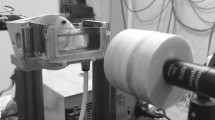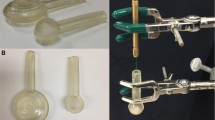Abstract
Artificial phantoms used in photothermal near-infrared laser lithotripsy research generally fail to mimic both the chemical and the physical properties of human stones. Though high-energy, 1 J pulses are capable of fracturing hard human stones into several large fragments along natural boundaries, similar behavior has not been observed in commonly used gypsum plasters like BegoStone. We developed a new brushite-based plaster formulation composed of ≈90% brushite that undergoes rapid fracture in the manner of human stones under fragmentation pulse regimes. Single-pulse (1 J) ablation crater volumes for phantoms were not significantly different from those of pure brushite stones. Control over crater volumes was demonstrated by varying phosphorous acid concentration in the plaster formulation. Fragmentation of cylindrical brushite phantoms was filmed using a high-speed camera which demonstrated rapid fragmentation in < 100 µs during the bubble expansion phase of a short pulse from a high-powered Ho:YAG laser (Lumenis Pulse 120 H). The rapid nature of observed fracture suggests increasing laser pulse energy by increasing laser pulse duration will not improve fragmentation performance of laser lithotripters. Brushite plaster phantoms are a superior alternative to gypsum plasters for laser lithotripsy research due to their better mimicry of stone composition, controllable single-pulse crater volumes, and fragmentation behavior.





Similar content being viewed by others
References
Liu Y, Zhong P (2002) BegoStone—a new stone phantom for shock wave lithotripsy research (L). J Acoust Soc Am 112:1265–1268. https://doi.org/10.1121/1.1501905
Esch E, Simmons WN, Sankin G et al (2010) A simple method for fabricating artificial kidney stones of different physical properties. Urol Res 38:315–319. https://doi.org/10.1007/s00240-010-0298-x
Heimbach D, Munver R, Zhong P et al (2000) Acoustic and mechanical properties of artificial stones in comparison to natural kidney stones. J Urol 164:537–544. https://doi.org/10.1016/S0022-5347(05)67419-8
Charles Chuong CJ, Zhong P, Preminger GM (1992) A comparison of stone damage caused by different modes of shock wave generation. J Urol 148:200–205. https://doi.org/10.1016/S0022-5347(17)36553-9
Rassweiler J, Irion U, Strauss R et al (1989) Technical considerations using a pulsed Neodym-YAG laser for endoscopic shock wave lithotripsy. Eur Urol 16:374–377. https://doi.org/10.1159/000471620
Frank DS, Aldoukhi AH, Roberts WW et al (2019) Polymer-mineral composites mimic human kidney stones in laser lithotripsy experiments. ACS Biomater Sci Eng 5:4970–4975. https://doi.org/10.1021/acsbiomaterials.9b01130
Shalini S, Frank DS, Aldoukhi AH et al (2020) Assessing the role of light absorption in laser lithotripsy by isotopic substitution of kidney stone materials. ACS Biomater Sci Eng 6:5274–5280. https://doi.org/10.1021/acsbiomaterials.0c00790
Robinson JW, Ghani KR, Roberts WW, Matzger AJ (2023) Near-infrared absorption coefficients in kidney stone minerals and their relation to crystal structure. J Phys Chem C 127:759–767. https://doi.org/10.1021/acs.jpcc.2c07475
King JB, Katta N, Teichman JMH et al (2021) Mechanisms of pulse modulated Holmium:YAG lithotripsy. J Endourol 35:S-29. https://doi.org/10.1089/end.2021.0742
Vassar GJ, Chan KF, Teichman JMH et al (1999) Holmium: YAG lithotripsy: photothermal mechanism. J Endourol 13:181–190. https://doi.org/10.1089/end.1999.13.181
Chan KF, Vassar GJ, Pfefer TJ et al (1999) Holmium:YAG laser lithotripsy: a dominant photothermal ablative mechanism with chemical decomposition of urinary calculi. Lasers Surg Med 25:22–37. https://doi.org/10.1002/(SICI)1096-9101(1999)25:1%3c22::AID-LSM4%3e3.0.CO;2-6
Taratkin M, Laukhtina E, Singla N et al (2021) How lasers ablate stones. in vitro study of laser lithotripsy (Ho:YAG and Tm-Fiber lasers) in different environments. J Endourol 35:931–936. https://doi.org/10.1089/end.2019.0441
Wong DG, Shiang A, Ostergar A, Sands KG (2023) Enhanced popcorning using polyanionic chelating solutions as irrigation. Urolithiasis 51:90. https://doi.org/10.1007/s00240-023-01464-0
Hecht SL, Wolf JS (2013) Techniques for holmium laser lithotripsy of intrarenal calculi. Urology 81:442–445. https://doi.org/10.1016/j.urology.2012.11.021
Aldoukhi AH, Roberts WW, Hall TL, Ghani KR (2019) Watch your distance: the role of laser fiber working distance on fragmentation when altering pulse width or modulation. J Endourol 33:120–126. https://doi.org/10.1089/end.2018.0572
Bader MJ, Pongratz T, Khoder W et al (2015) Impact of pulse duration on Ho:YAG laser lithotripsy: fragmentation and dusting performance. World J Urol 33:471–477. https://doi.org/10.1007/s00345-014-1429-8
Lilley KJ, Gbureck U, Wright AJ et al (2005) Cement from nanocrystalline hydroxyapatite: effect of calcium phosphate ratio. J Mater Sci Mater Med 16:1185–1190. https://doi.org/10.1007/s10856-005-4727-2
Ishikawa K (2010) Bone substitute fabrication based on dissolution-precipitation reactions. Materials 3:1138–1155. https://doi.org/10.3390/ma3021138
Bai H, Walsh F, Gludovatz B et al (2016) Bioinspired hydroxyapatite/poly(methyl methacrylate) composite with a nacre-mimetic architecture by a bidirectional freezing method. Adv Mater 28:50–56. https://doi.org/10.1002/adma.201504313
Zhang J, Liu W, Schnitzler V et al (2014) Calcium phosphate cements for bone substitution: chemistry, handling and mechanical properties. Acta Biomater 10:1035–1049. https://doi.org/10.1016/j.actbio.2013.11.001
Alkhraisat MH, Mariño FT, Rodríguez CR et al (2008) Combined effect of strontium and pyrophosphate on the properties of brushite cements. Acta Biomater 4:664–670. https://doi.org/10.1016/j.actbio.2007.12.001
Tamimi F, Sheikh Z, Barralet J (2012) Dicalcium phosphate cements: brushite and monetite. Acta Biomater 8:474–487. https://doi.org/10.1016/j.actbio.2011.08.005
Xu HH, Wang P, Wang L et al (2017) Calcium phosphate cements for bone engineering and their biological properties. Bone Res 5:1–19. https://doi.org/10.1038/boneres.2017.56
Bohner M, Lemaitre J, Ring TA (1996) Effects of sulfate, pyrophosphate, and citrate ions on the physicochemical properties of cements made of β-tricalcium phosphate-phosphoric acid-water mixtures. J Am Ceram Soc 79:1427–1434. https://doi.org/10.1111/j.1151-2916.1996.tb08746.x
Marom R, Roberts WW, Hall TL et al (2023) Characterization of thulium fiber laser pulses: differences between short and long pulse. J Urol 209:e360. https://doi.org/10.1097/JU.0000000000003254.19
Sivaguru M, Lieske JC, Krambeck AE, Fouke BW (2020) GeoBioMed sheds new light on human kidney stone crystallization and dissolution. Nat Rev Urol 17:1–2. https://doi.org/10.1038/s41585-019-0256-5
Sivaguru M, Saw JJ, Wilson EM et al (2021) Human kidney stones: a natural record of universal biomineralization. Nat Rev Urol 18:404–432. https://doi.org/10.1038/s41585-021-00469-x
Daudon M, Bazin D, André G et al (2009) Examination of whewellite kidney stones by scanning electron microscopy and powder neutron diffraction techniques. J Appl Crystallogr 42:109–115. https://doi.org/10.1107/S0021889808041277
Funding
Funding for this research was provided through a research grant from Boston Scientific.
Author information
Authors and Affiliations
Contributions
JWR was the primary developer of new materials and experimental methodology for this work. RM aided JWR in developing and performing lithotripsy experiments. AJM and WWR: supervised experimental work. All authors contributed to conceptualization. JWR: wrote the first draft of this manuscript and all authors contributed to editing and review of the manuscript.
Corresponding author
Ethics declarations
Conflict of interest
William W. Roberts has a consulting relationship with Boston Scientific. Khurshid R Ghani has a consulting relationship with Boston Scientific, Ambu, Coloplast, Karl Storz and Olympus.
Additional information
Publisher's Note
Springer Nature remains neutral with regard to jurisdictional claims in published maps and institutional affiliations.
Supplementary Information
Below is the link to the electronic supplementary material.
Rights and permissions
Springer Nature or its licensor (e.g. a society or other partner) holds exclusive rights to this article under a publishing agreement with the author(s) or other rightsholder(s); author self-archiving of the accepted manuscript version of this article is solely governed by the terms of such publishing agreement and applicable law.
About this article
Cite this article
Robinson, J.W., Marom, R., Ghani, K.R. et al. Performance of brushite plaster as kidney stone phantoms for laser lithotripsy. Urolithiasis 52, 10 (2024). https://doi.org/10.1007/s00240-023-01505-8
Received:
Accepted:
Published:
DOI: https://doi.org/10.1007/s00240-023-01505-8




